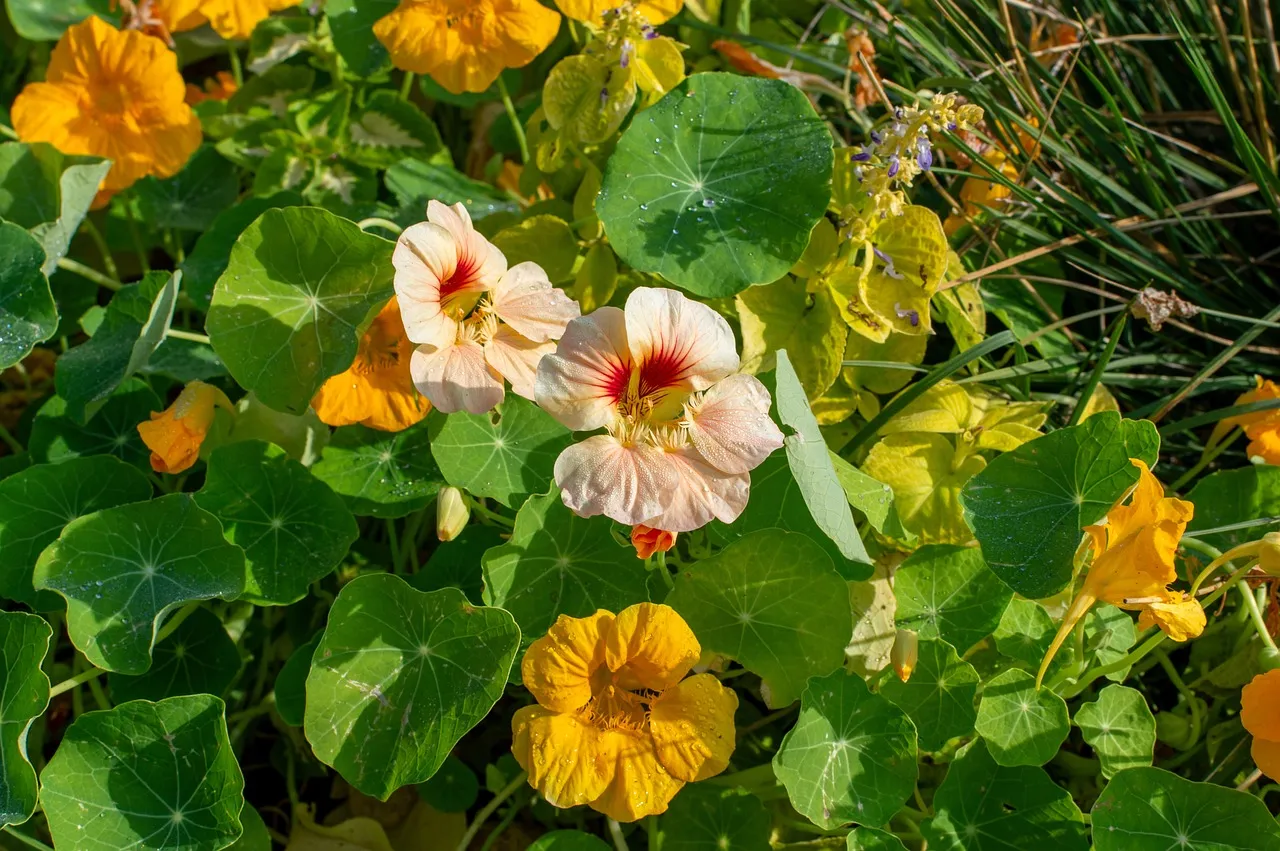Welcome to our comprehensive blog post on “Nasturtiums: Annual or Perennial? Discover the Best Choice for Your Balcony.” If you’ve ever wondered about the longevity of these beautiful and versatile flowers in your balcony garden, you’ve come to the right place. In this article, we will delve into the fascinating world of Nasturtiums, exploring their growth habits, lifecycle, and essential care tips to help you make the optimal choice for your outdoor sanctuary.
Whether you’re a seasoned gardener or just starting, let’s embark on this gardening journey together and unlock the secrets of choosing the perfect Nasturtiums for your balcony oasis. Let the floral adventure begin! 🌼🌿 #BalconyGardening #Nasturtiums
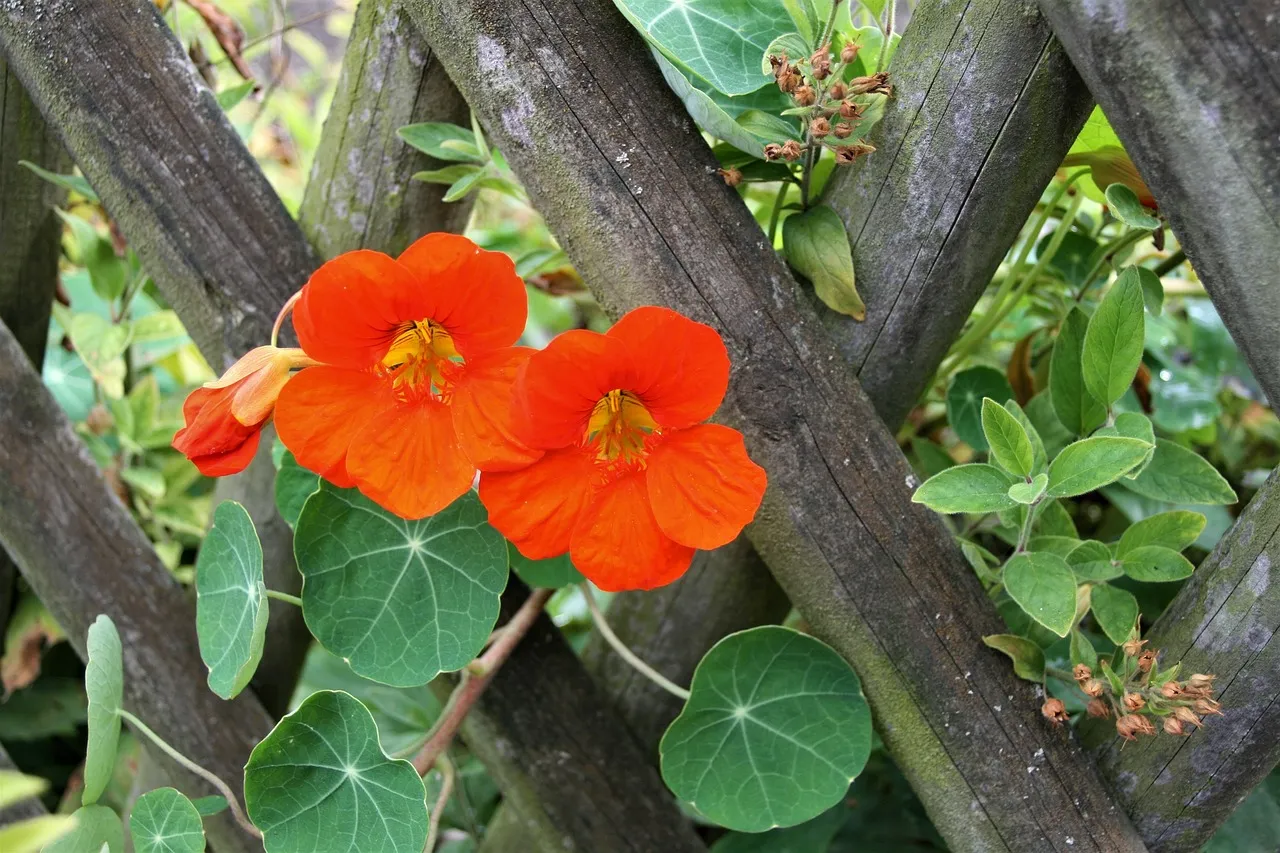
Nasturtiums Unveiled: An In-depth Overview
Nasturtiums, also known by their scientific name Tropaeolum majus, are charming and versatile flowering plants that have captivated gardeners for centuries. This in-depth overview will delve into the fascinating world of Nasturtiums, exploring their origin, botanical characteristics, and historical significance. These delightful plants, native to South America, were introduced to Europe in the 16th century and have since become popular ornamental and edible additions to gardens worldwide.
With their bright and eye-catching flowers in a wide range of colors, Nasturtiums have become a popular choice for balcony gardens, adding a splash of vibrancy to any outdoor space. They are highly valued for their ability to attract beneficial insects, thus aiding in natural pest control and promoting biodiversity. Additionally, Nasturtiums possess edible flowers and leaves with a peppery taste, making them a unique and tasty addition to various culinary dishes.
Types of Nasturtiums:
Empress of India:
Empress of India is a popular Nasturtium variety known for its stunning, deep crimson flowers. As an annual plant, it showcases vigorous growth and thrives in both containers and garden beds. With its attractive green foliage, the vibrant flowers create a striking contrast, making it a focal point in any balcony garden.
This variety is cherished for its versatility, as it can be used to cascade gracefully from hanging baskets or add a pop of color to trellises and fences. Empress of India’s fast growth rate and ability to attract beneficial pollinators make it a delightful addition to any balcony garden, offering beauty and functionality.
Alaska Mix:
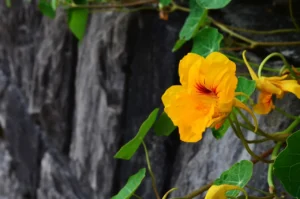
The Alaska Mix Nasturtium variety is a captivating blend of colors, boasting beautiful cream, yellow, and orange blooms. These annual plants are easy to grow, making them an ideal choice for beginner gardeners. They are particularly suited for balcony gardens due to their compact size and trailing growth habit.
Whether in containers, window boxes, or hanging baskets, Alaska Mix Nasturtiums bring a charming touch to any outdoor space. Their mounding foliage and colorful flowers create a visually appealing display throughout the growing season, adding a touch of vibrancy and cheerfulness to your balcony sanctuary.
Jewel Mix:
Jewel Mix Nasturtiums are a delightful assortment of warm and rich colors, including shades of red, orange, and gold. These annual plants are a true gem for balcony gardens, as they are not only visually striking but also edible. Their peppery leaves and flowers can be used to enhance salads, giving your culinary creations a unique twist.
These compact and bushy plants are well-suited for containers and window boxes, bringing a burst of color to even the smallest of spaces. Jewel Mix Nasturtiums are low-maintenance and thrive in sunny locations, rewarding you with a bountiful display of attractive blooms all season long.
Whirlybird Series:
The Nasturtium’s Whirlybird Series features large, semi-double flowers in vibrant shades like orange, red, and yellow. These annuals are beloved by balcony gardeners for their eye-catching appearance. Resembling spinning propellers, their unique upward-facing blooms add whimsy to any setting. Versatile and suitable for containers, hanging baskets, or directly in the ground, they boast lush green foliage that complements the striking flowers, making them a captivating choice for balcony gardening.
Cherry Rose Jewel:
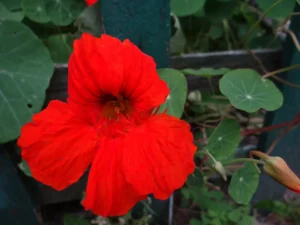
The Cherry Rose Jewel Nasturtium variety mesmerizes with red and pink hues, resembling cherry blossoms. As an annual, it adds charm and romance to balcony gardens. Its compact and bushy form suits containers and small spaces, creating an elegant outdoor sanctuary. Delicate yet resilient flowers bloom profusely, becoming a lovely focal point on your balcony. With easy-care and graceful beauty, it enhances any balcony garden’s aesthetics.
Black Velvet:
As the name suggests, Black Velvet Nasturtiums exhibit deep, velvety crimson-red flowers that create a stunning contrast against their dark green foliage. This unique and eye-catching annual variety is a must-have for balcony gardeners seeking to add drama and sophistication to their outdoor spaces.
The Black Velvet Nasturtium’s climbing habit makes it an excellent choice for trellises, fences, and balcony railings, allowing it to reach its full potential in vertical displays. Its striking appearance and climbing abilities are sure to captivate onlookers, making it a standout feature in your balcony garden.
Peach Melba:
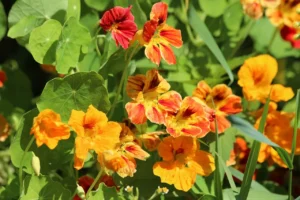
Peach Melba Nasturtiums are a delightful annual variety with soft and delicate peach-colored flowers that exhibit a hint of creamy white. This gentle and elegant color palette is ideal for creating a soothing ambiance in your balcony garden. Their compact growth habit makes them suitable for containers and small spaces, making it easy to incorporate them into any balcony design.
In addition to their aesthetic appeal, Peach Melba Nasturtiums also attract beneficial insects, making them a valuable asset for promoting biodiversity in your garden. With their calming and graceful presence, these Nasturtiums add a touch of tranquility to your balcony retreat.
Canary Creeper:
Canary Creeper Nasturtiums are an alluring annual vine variety known for their unique bright yellow, elongated blooms. This climber is an excellent choice for balcony gardeners seeking to add vertical interest and create greenery curtains along railings or trellises. The Canary Creeper’s vibrant yellow flowers add a splash of sunshine to any balcony, infusing your outdoor space with energy and cheerfulness.
As a fast-growing and low-maintenance vine, it quickly covers vertical surfaces, providing a lush and enchanting backdrop to your balcony oasis.
Moonlight:
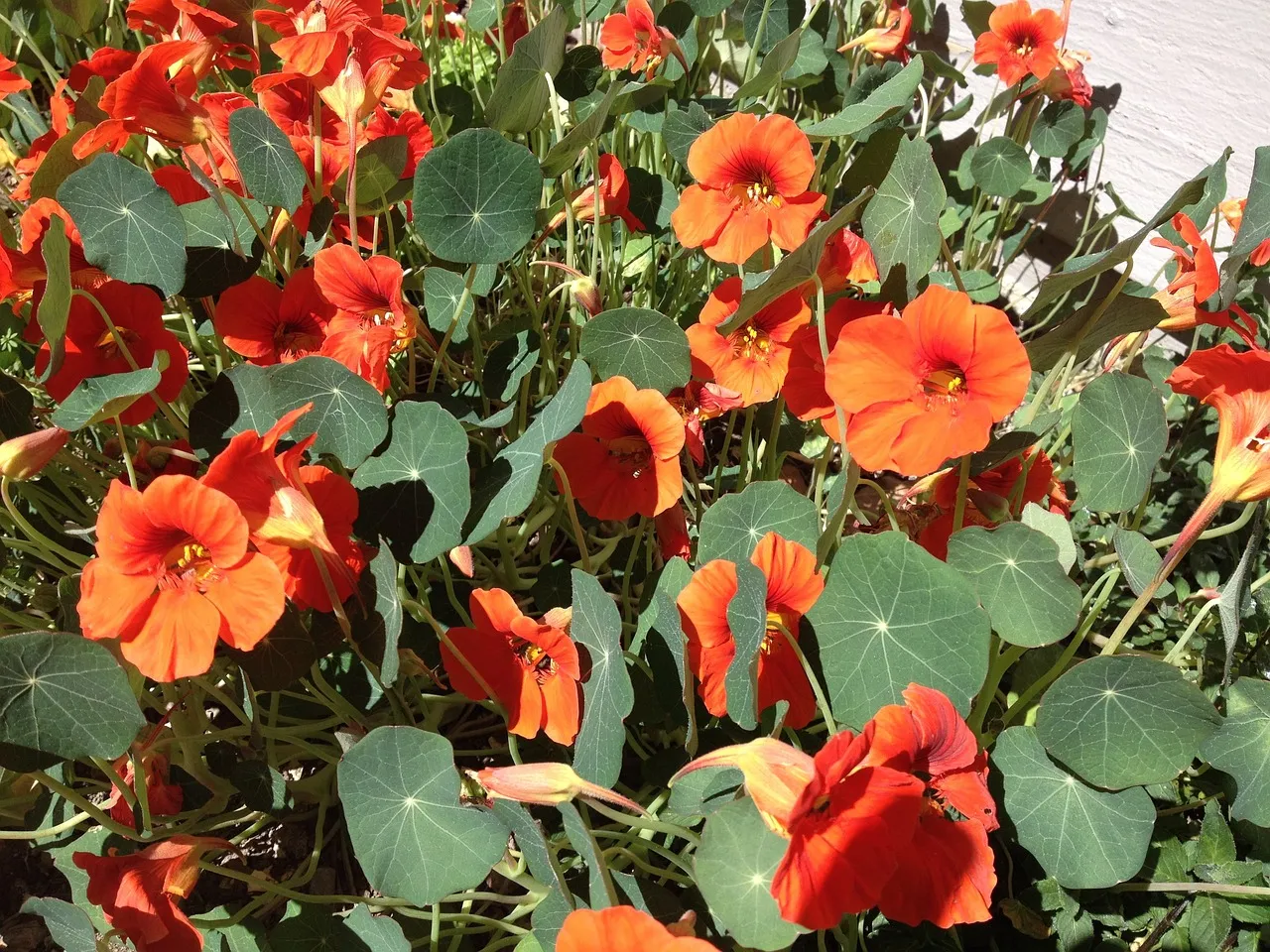
The Moonlight Nasturtium variety is a captivating annual with pastel-hued flowers in shades of cream, pale yellow, and soft peach. This delicate and ethereal color palette infuses your balcony garden with a sense of tranquility and elegance. Moonlight Nasturtiums are perfect for balcony containers, window boxes, or as ground cover to create a soothing and serene atmosphere.
Their trailing and mounding growth habit adds a touch of grace to your outdoor space, making it an inviting retreat to unwind and enjoy the beauty of nature.
Phoenix:
Phoenix Nasturtiums are a striking annual variety that displays a brilliant blend of warm colors, including shades of scarlet, gold, and orange. These captivating flowers create a fiery and eye-catching display, adding a touch of drama to your balcony garden. As a climbing Nasturtium, Phoenix is an excellent choice for balcony railings, trellises, or fences, allowing it to reach its full potential in vertical displays.
Its bold and vibrant appearance is sure to command attention and make a strong statement in your balcony garden design.
Decoding the Lifecycle: Annual vs. Perennial Nasturtiums
One of the primary factors to consider when choosing Nasturtiums for your balcony garden is their lifecycle. Nasturtiums can be categorized into two main types: annual and perennial.
Annual Nasturtiums complete their lifecycle in one growing season. These plants germinate from seeds, grow vigorously throughout the spring and summer, and produce a profusion of colorful blooms. As the growing season comes to an end, annual Nasturtiums set seeds for the next generation before withering away with the arrival of frost. Their adaptability and quick growth make them a fantastic choice for gardeners seeking a burst of seasonal color and continuous floral display.
On the other hand, perennial Nasturtiums can persist for multiple growing seasons if provided with the right conditions. These varieties, such as the Phoenix Nasturtium, are better suited for milder climates. In areas with frost-free winters, perennial Nasturtiums can behave as short-lived perennials, delighting gardeners with their long-term beauty and persistent presence in the garden.
Advantages of Annual Nasturtiums for Balcony Gardens
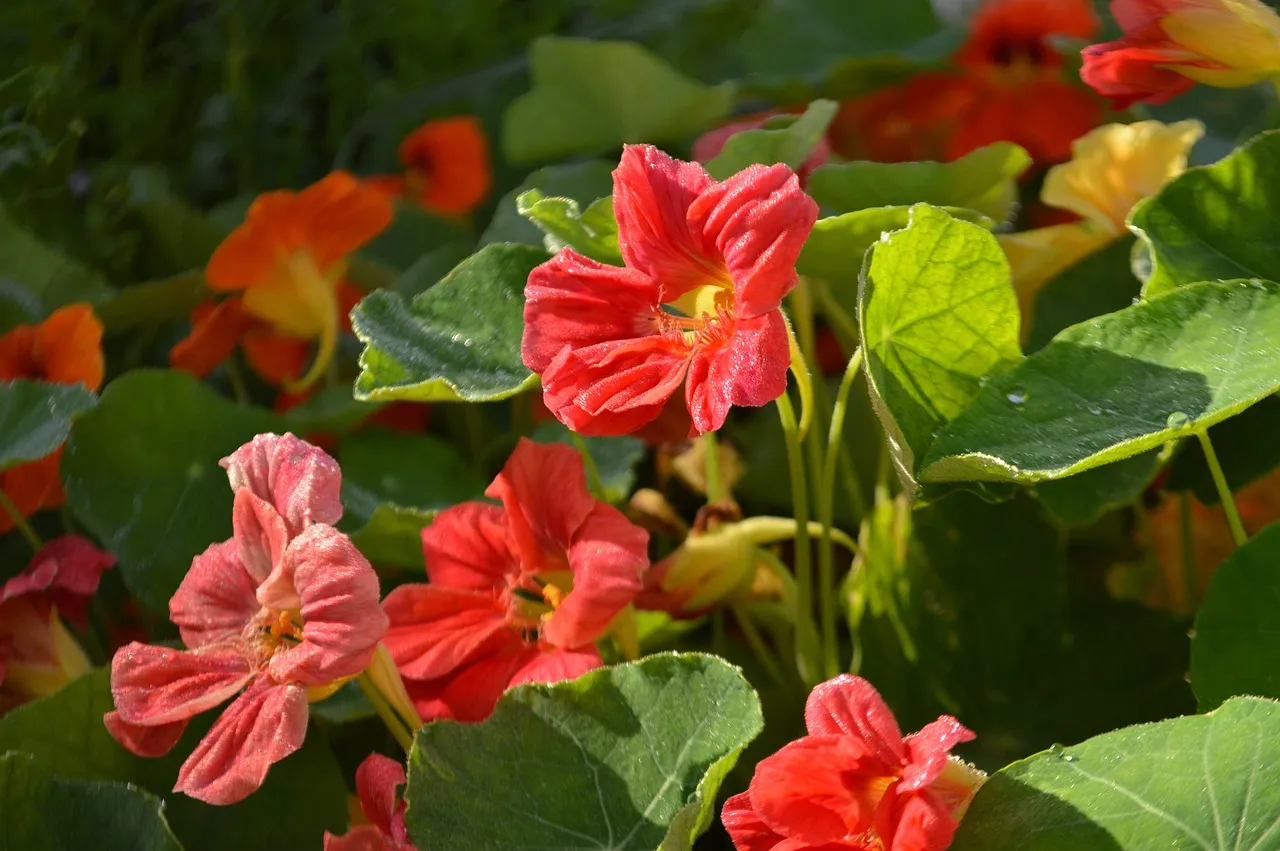
Annual Nasturtiums offer several advantages that make them an excellent choice for balcony gardens. Their quick growth and ability to flower abundantly throughout the growing season provide an immediate burst of color and vitality to your outdoor sanctuary. Additionally, their compact size and trailing growth habit make them perfect for small spaces, such as balconies, where space may be limited.
These plants are relatively easy to grow, making them suitable for gardeners of all skill levels. With their preference for full sun and well-draining soil, they are low-maintenance and do not require elaborate care routines. Regular deadheading of spent flowers encourages continuous blooming, ensuring a continuous supply of eye-catching blooms to brighten up your balcony garden.
Perennial Nasturtiums: Long-Term Beauty for Your Balcony
Perennial Nasturtiums offer the advantage of longevity, providing long-term beauty and enjoyment in your balcony garden. Varieties like the Phoenix Nasturtium can persist for multiple growing seasons, adding a touch of elegance to your outdoor space year after year.
These perennial varieties require similar care to their annual counterparts, thriving in full sun and well-draining soil. While they may not produce as profuse blooms as annual Nasturtiums in a single season, their consistent presence and return year after year make them a valuable addition to a balcony garden with a more permanent character.
Factors Influencing Nasturtiums’ Growth and Flowering
The growth and flowering of Nasturtiums on your balcony are influenced by various factors. Sunlight is crucial, as these plants thrive in full sun, requiring 6-8 hours of direct sunlight daily. Insufficient sunlight may result in fewer blooms and weaker growth.
Soil quality also plays a significant role in the health and performance of Nasturtiums. They prefer well-draining soil that is moderately fertile. Soil that retains too much moisture can lead to root rot and other issues, affecting the overall health of the plants.
Proper watering is essential for the successful growth of Nasturtiums. These plants prefer moderate moisture levels and can tolerate short periods of drought. Overwatering can lead to waterlogged soil and may cause root rot.
Balcony-Friendly Nasturtium Varieties to Consider
When selecting Nasturtiums for your balcony garden, consider varieties that are well-suited for container growing and small spaces. Compact and bushy varieties like the Alaska Mix and Moonlight are ideal choices for balconies with limited room. These varieties offer stunning blooms in a range of colors, adding visual appeal to your outdoor space.
For those with vertical surfaces to fill, climbing varieties like the Canary Creeper and Black Velvet provide a wonderful option. These Nasturtiums will elegantly trail along trellises or balcony railings, creating a cascading floral display that enhances the aesthetics of your balcony garden.
Growing Nasturtiums from Seed: Step-by-Step Guide
Growing Nasturtiums from seeds is a rewarding experience that allows you to witness the entire lifecycle of these delightful plants. To get started, gather high-quality Nasturtium seeds from a reliable source or purchase them from a reputable nursery.
Prepare a well-draining potting mix and fill seedling trays or small pots with the soil. Sow the Nasturtium seeds about half an inch deep in each container, then gently water the soil to keep it moist.
Place the seedling trays or pots in a sunny location where the seeds can receive ample sunlight. Germination usually occurs within 7-10 days, and soon, you’ll see tiny seedlings emerging from the soil.
As the Nasturtium seedlings grow, ensure they receive enough sunlight to develop strong and healthy stems and foliage. Once the seedlings have grown to a suitable size, you can transplant them into larger containers or directly into your balcony garden.
Caring for Nasturtiums: Watering, Fertilizing, and Pruning Tips
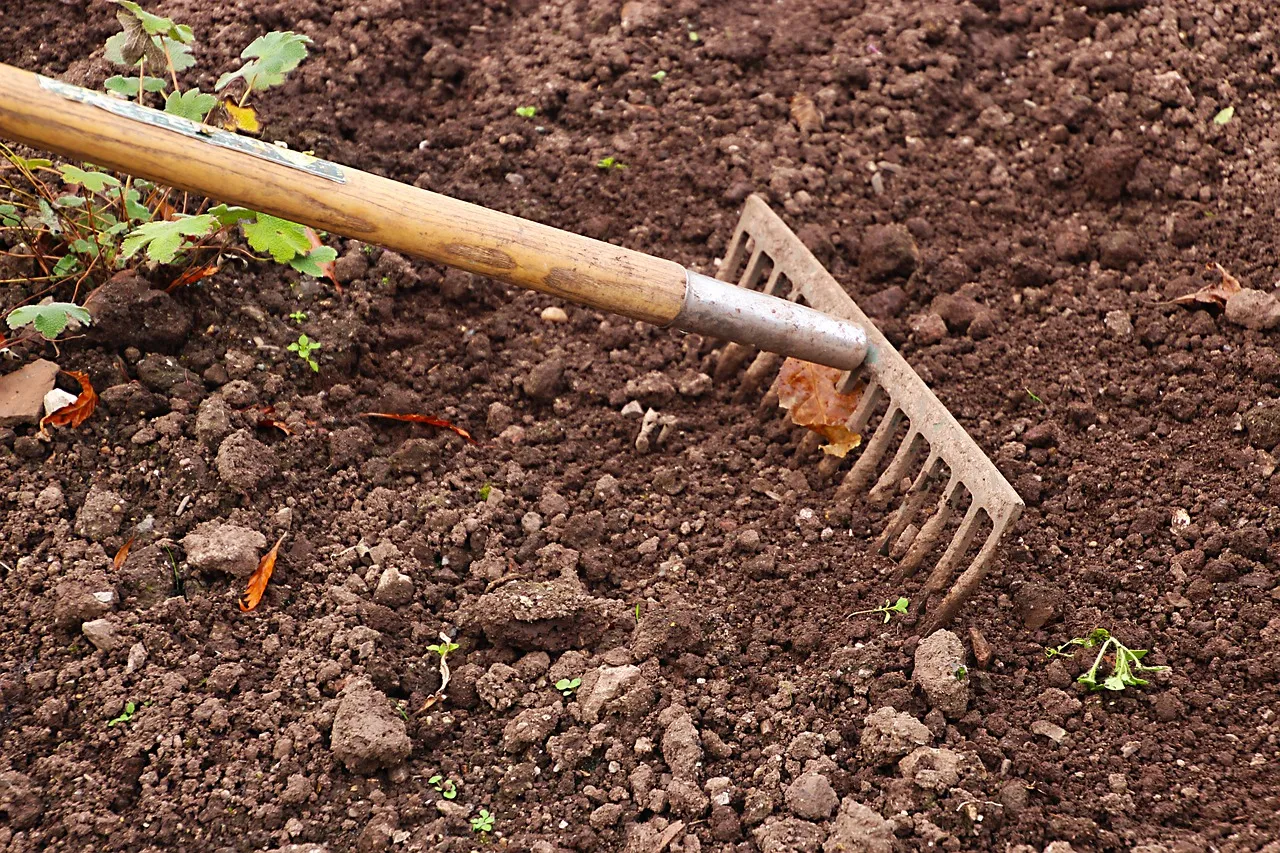
Caring for Nasturtiums is relatively simple, but proper attention to watering, fertilizing, and pruning will ensure robust and healthy growth. Nasturtiums prefer moderate moisture levels in the soil, so it’s essential to water them regularly. However, be cautious not to overwater, as they can tolerate short periods of drought and may suffer from root rot in waterlogged soil.
Fertilizing Nasturtiums should be done with a balanced organic fertilizer. Avoid excessive use of nitrogen-based fertilizers, as this may encourage foliage growth at the expense of flowering. A balanced approach to fertilizing will promote both lush foliage and abundant blooms.
Pruning Nasturtiums is a vital aspect of caring for these plants. Regularly deadheading spent flowers helps to promote continuous blooming throughout the growing season. It also prevents the plants from diverting energy into seed production, directing it instead towards the growth of new flowers.
Creative Ways to Incorporate Nasturtiums into Your Balcony Design
Nasturtiums offer a myriad of creative possibilities when it comes to incorporating them into your balcony design. Their vibrant colors and attractive growth habits make them excellent candidates for various decorative arrangements.
Plant Nasturtiums in hanging baskets or window boxes to create cascading floral displays that spill over the edges, adding a touch of visual drama to your balcony. Alternatively, consider using trellises or balcony railings as vertical spaces to grow climbing Nasturtium varieties like the Canary Creeper or Black Velvet.
Mix Nasturtiums with other complementary flowers and foliage plants to create captivating floral compositions that showcase the beauty of these charming plants. Use contrasting colors and varying heights to add depth and dimension to your balcony garden.
Nasturtium Companion Plants: Enhancing Balcony Biodiversity
Nasturtiums not only add beauty but also offer a crucial advantage to your balcony garden: they make excellent companion plants. Companion planting involves placing specific plants together to enhance growth and deter pests.
Nasturtiums release chemical compounds that act as natural insect repellents, making them effective in deterring pests from nearby plants. For instance, planting Nasturtiums near vegetables like cucumbers, tomatoes, or radishes can help protect them from aphids and other pests.
Debunking Common Myths About Nasturtiums
As with any popular plant, Nasturtiums have their fair share of myths and misconceptions. One common myth is that Nasturtiums are invasive plants that take over gardens. While they are vigorous growers, they are not considered invasive and can be easily managed through regular pruning and deadheading.
Another misconception is that Nasturtiums are challenging to grow. In reality, they are relatively easy to care for and are well-suited for both experienced and novice gardeners. With proper sunlight, well-draining soil, and moderate watering, Nasturtiums can thrive and provide a beautiful display of blooms.
Overwintering Nasturtiums: Ensuring Perennial Success
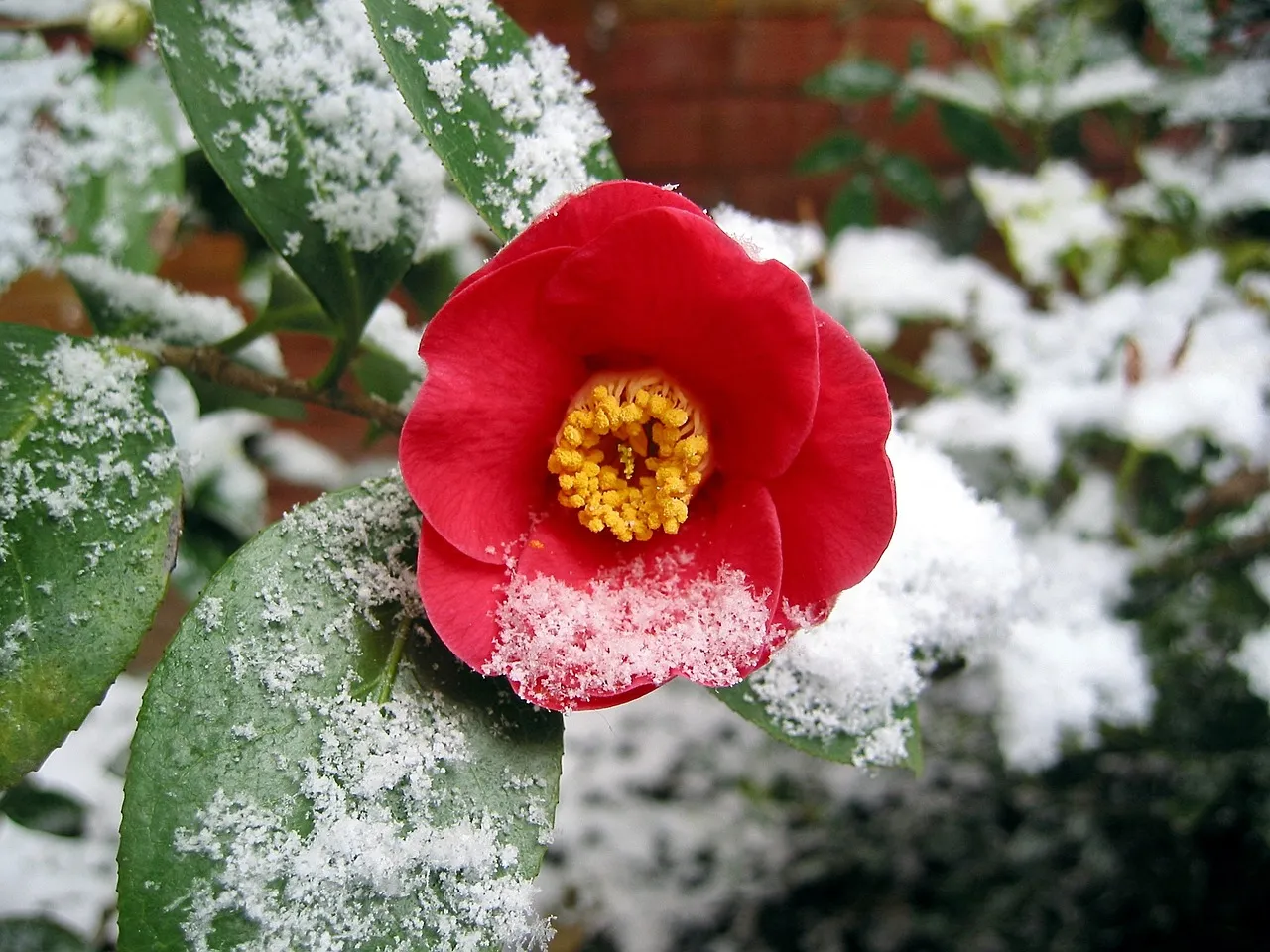
For gardeners in regions with mild winters, overwintering perennial Nasturtiums can be a rewarding experience. While most Nasturtium varieties are annuals and won’t survive cold winters, certain perennial varieties, like the Phoenix Nasturtium, can persist with proper care.
To overwinter perennial Nasturtiums, ensure they are in a suitable growing location with adequate sunlight and well-draining soil. Before the first frost, cut back the plants to encourage dormancy. Mulch around the base of the plants to protect their roots from cold temperatures.
During winter, water them sparingly to prevent overwatering during their dormant period. In spring, as temperatures rise, resume regular watering and watch as your perennial Nasturtiums reawaken and grace your balcony garden with their long-term beauty.
Troubleshooting Nasturtium Issues: Pest and Disease Management
Like all plants, Nasturtiums may face challenges in the form of pests and diseases. Fortunately, they are relatively resistant to most common garden pests. However, they can attract aphids and caterpillars, which can be managed using organic pest control methods, such as spraying them off with a strong stream of water or introducing beneficial insects like ladybugs.
As for diseases, Nasturtiums may occasionally encounter issues like powdery mildew or rust. These fungal diseases can be minimized by ensuring adequate airflow around the plants, avoiding overhead watering, and providing proper spacing between them.
Nasturtiums in Containers: A Space-Saving Option for Balcony Gardeners
One of the greatest advantages of Nasturtiums is their suitability for container gardening, making them an ideal choice for balcony gardeners with limited space. These plants thrive in containers and can adapt well to various container types, including pots, window boxes, and hanging baskets.
When choosing containers for Nasturtiums, consider their compact and trailing growth habit. Containers with ample drainage holes are essential to prevent waterlogged soil. Use a high-quality potting mix that offers good aeration and water retention.
Position the containers in a sunny location on your balcony, ensuring they receive the recommended 6-8 hours of direct sunlight daily. Regularly water the Nasturtiums, allowing the soil to dry slightly between waterings to avoid overwatering.
Harvesting and Using Nasturtium Flowers in the Kitchen
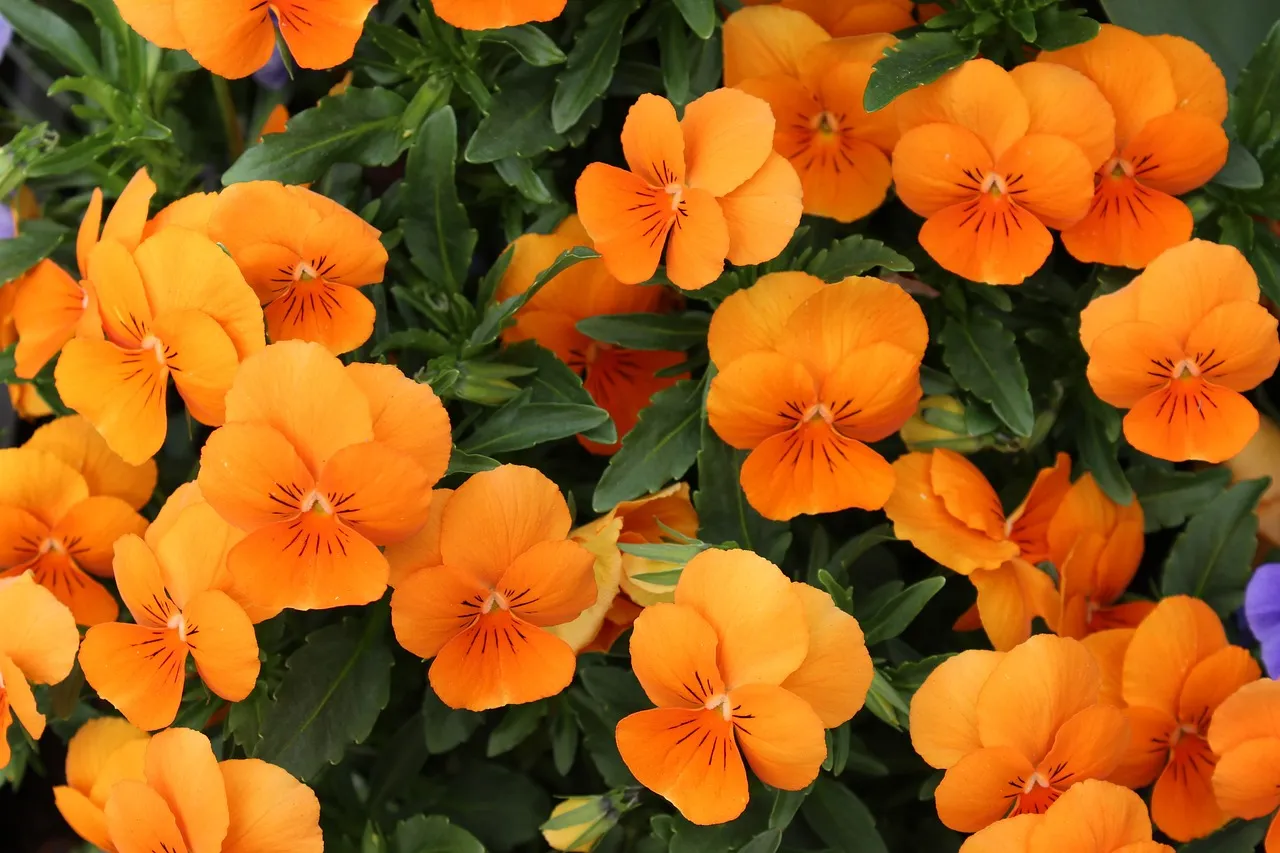
One of the unique features of Nasturtiums is their edible flowers and leaves. Harvesting Nasturtium flowers is a delightful experience that allows you to incorporate these beautiful blooms into your culinary creations.
To harvest Nasturtium flowers, simply pick them from the plant, ensuring to remove the bitter white base at the back of the flower. The flowers have a peppery flavor reminiscent of watercress, adding a delightful zing to salads, sandwiches, and garnishes.
Nasturtium leaves are also edible and have a similar peppery taste. They can be used in salads, pesto, or as a garnish for various dishes. Harvest the leaves when they are young and tender for the best flavor.
Conclusion
In conclusion, Nasturtiums offer a rich and diverse array of options for balcony gardeners seeking to add beauty, color, and functionality to their outdoor sanctuaries. Whether you choose annual varieties for a burst of seasonal blooms or perennial varieties for long-term elegance, Nasturtiums are sure to enchant and captivate.
Understanding their growth habits, care requirements, and creative possibilities enables you to make an informed choice for your balcony garden and discover the best Nasturtiums to elevate your outdoor space. Happy gardening and enjoy the beauty of Nasturtiums in your balcony oasis! 🌸🌿 #BalconyGardening #Nasturtiums
Most Frequently Asked Questions on Nasturtiums:
Are Nasturtiums annual or perennial plants?
Nasturtiums are mostly annual plants, meaning they complete their lifecycle in one growing season. However, some varieties, like the Phoenix Nasturtium, can behave as short-lived perennials in mild climates. Understanding their growth habits helps in making the best choice for your balcony garden.
Can I grow Nasturtiums in containers on my balcony?
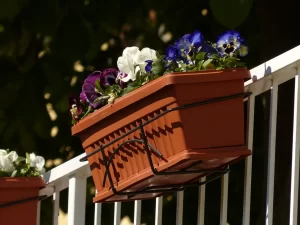
Absolutely! Nasturtiums are well-suited for container gardening. Their compact size and trailing growth make them perfect for hanging baskets, window boxes, or even small pots. Their vibrant colors will add a burst of beauty to your balcony.
How do I start growing Nasturtiums from seeds?
Starting Nasturtiums from seeds is simple. Prepare a well-draining potting mix, sow the seeds about 1/2 inch deep, and keep the soil moist. Germination usually occurs within 7-10 days. Once they sprout, provide plenty of sunlight for healthy growth.
Are Nasturtiums easy to care for?
That’s correct. Nasturtiums are low-maintenance and thrive in full sun with well-draining soil. Water regularly, but avoid overwatering, as they can tolerate drought. Continuously deadhead spent flowers for continuous blooming.
Can I eat Nasturtium flowers?
Absolutely! Nasturtium flowers have a peppery flavor and are edible. They make a wonderful addition to salads, adding both color and a mild spice. Ensure you’ve grown them organically without the use of harmful chemicals.
Do Nasturtiums attract pests or insects?
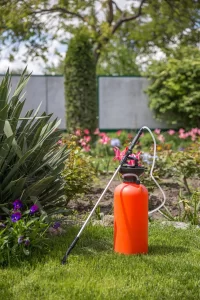
Nasturtiums are known to attract beneficial insects like ladybugs and bees, which help in natural pest control. However, they may also attract aphids and caterpillars, which you can manage by using organic pest control methods.
How do I promote more flowers on my Nasturtiums?
For more blooms, provide enough sunlight and nutrients to your Nasturtiums. Regularly deadhead spent flowers to promote new blooms. A balanced organic fertilizer can also boost flowering.
Can I overwinter Nasturtiums?
Most Nasturtiums are annuals, so they won’t survive cold winters. However, some perennial varieties, like the Phoenix Nasturtium, can withstand mild winter conditions. In colder regions, consider replanting new Nasturtiums in the following growing season.
Can Nasturtiums grow in shady balconies?
Nasturtiums thrive in full sun, but they can tolerate some light shade. If your balcony receives at least 4-6 hours of sunlight per day, they should still bloom beautifully. However, prolonged shade may affect their flowering.
How do I use Nasturtiums as companion plants?
Nasturtiums make excellent companion plants as they deter certain pests and attract beneficial insects. Plant them near vegetables like cucumbers, tomatoes, or radishes to help protect them from pests and enhance pollination.
